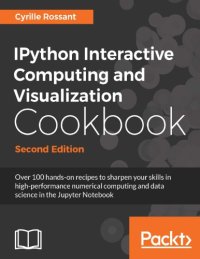
Ebook: IPython Interactive Computing and Visualization Cookbook
Author: Cyrille Rossant
- Genre: Computers // Cybernetics: Artificial Intelligence
- Tags: Machine Learning, Data Analysis, Natural Language Processing, Image Processing, OpenCV, Debugging, Python, JavaScript, Graphs, Face Recognition, Bayesian Inference, Classification, Clustering, Support Vector Machines, Ordinary Differential Equations, Asynchronous Programming, Data Visualization, R, Statistics, Numerical Methods, Optimization, Monte Carlo Simulation, Profiling, scikit-learn, NumPy, matplotlib, D3.js, Jupyter, NetworkX, HDF5, SciPy, OpenMP, CUDA, Git, Fourier Transform, Geographic Information Systems, Random Forest
- Year: 2018
- Publisher: Packt Publishing
- City: Birmingham, UK
- Edition: 2
- Language: English
- pdf
Learn to use IPython and Jupyter Notebook for your data analysis and visualization work
Key Features
• Leverage the Jupyter Notebook for interactive data science and visualization
• Become an expert in high-performance computing and visualization for data analysis and scientific modeling
• Comprehensive coverage of scientific computing through many hands-on, example-driven recipes with detailed, step-by-step explanations
Book Description
Python is one of the leading open source platforms for data science and numerical computing. IPython and the associated Jupyter Notebook offer efficient interfaces to Python for data analysis and interactive visualization, and constitute an ideal gateway to the platform.
This second edition of IPython Interactive Computing and Visualization Cookbook contains many ready-to-use, focused recipes for high-performance scientific computing and data analysis, from the latest IPython/Jupyter features to the most advanced tricks, to help you write better and faster code. You will apply these state-of-the-art methods to various real-world examples, illustrating topics in applied mathematics, scientific modeling, and machine learning.
The first part of the book covers programming techniques: code quality and reproducibility, code optimization, high-performance computing through just-in-time compilation, parallel computing, and graphics card programming. The second part tackles data science, statistics, machine learning, signal and image processing, dynamical systems, and pure and applied mathematics.
What you will learn
• Master all features of the Jupyter Notebook
• Code better: write high-quality, readable, and well-tested programs; profile and optimize your code; and conduct reproducible interactive computing experiments
• Visualize data and create interactive plots in the Jupyter Notebook
• Write blazingly fast Python programs with NumPy, ctypes, Numba, Cython, OpenMP, GPU programming (CUDA), parallel IPython, Dask, and more
• Analyze data with Bayesian or frequentist statistics (Pandas, PyMC, and R), and learn from actual data through machine learning (scikit-learn)
• Gain valuable insights into signals, images, and sounds with SciPy, scikit-image, and OpenCV
• Simulate deterministic and stochastic dynamical systems in Python
• Familiarize yourself with math in Python using SymPy and Sage: algebra, analysis, logic, graphs, geometry, and probability theory
Who This Book Is For
This book is for anyone interested in numerical computing and data science: students, researchers, teachers, engineers, analysts, and hobbyists. Basic knowledge of Python/NumPy is recommended. Some skills in mathematics will help you understand the theory behind the computational methods.
Key Features
• Leverage the Jupyter Notebook for interactive data science and visualization
• Become an expert in high-performance computing and visualization for data analysis and scientific modeling
• Comprehensive coverage of scientific computing through many hands-on, example-driven recipes with detailed, step-by-step explanations
Book Description
Python is one of the leading open source platforms for data science and numerical computing. IPython and the associated Jupyter Notebook offer efficient interfaces to Python for data analysis and interactive visualization, and constitute an ideal gateway to the platform.
This second edition of IPython Interactive Computing and Visualization Cookbook contains many ready-to-use, focused recipes for high-performance scientific computing and data analysis, from the latest IPython/Jupyter features to the most advanced tricks, to help you write better and faster code. You will apply these state-of-the-art methods to various real-world examples, illustrating topics in applied mathematics, scientific modeling, and machine learning.
The first part of the book covers programming techniques: code quality and reproducibility, code optimization, high-performance computing through just-in-time compilation, parallel computing, and graphics card programming. The second part tackles data science, statistics, machine learning, signal and image processing, dynamical systems, and pure and applied mathematics.
What you will learn
• Master all features of the Jupyter Notebook
• Code better: write high-quality, readable, and well-tested programs; profile and optimize your code; and conduct reproducible interactive computing experiments
• Visualize data and create interactive plots in the Jupyter Notebook
• Write blazingly fast Python programs with NumPy, ctypes, Numba, Cython, OpenMP, GPU programming (CUDA), parallel IPython, Dask, and more
• Analyze data with Bayesian or frequentist statistics (Pandas, PyMC, and R), and learn from actual data through machine learning (scikit-learn)
• Gain valuable insights into signals, images, and sounds with SciPy, scikit-image, and OpenCV
• Simulate deterministic and stochastic dynamical systems in Python
• Familiarize yourself with math in Python using SymPy and Sage: algebra, analysis, logic, graphs, geometry, and probability theory
Who This Book Is For
This book is for anyone interested in numerical computing and data science: students, researchers, teachers, engineers, analysts, and hobbyists. Basic knowledge of Python/NumPy is recommended. Some skills in mathematics will help you understand the theory behind the computational methods.
Download the book IPython Interactive Computing and Visualization Cookbook for free or read online
Continue reading on any device:

Last viewed books
Related books
{related-news}
Comments (0)